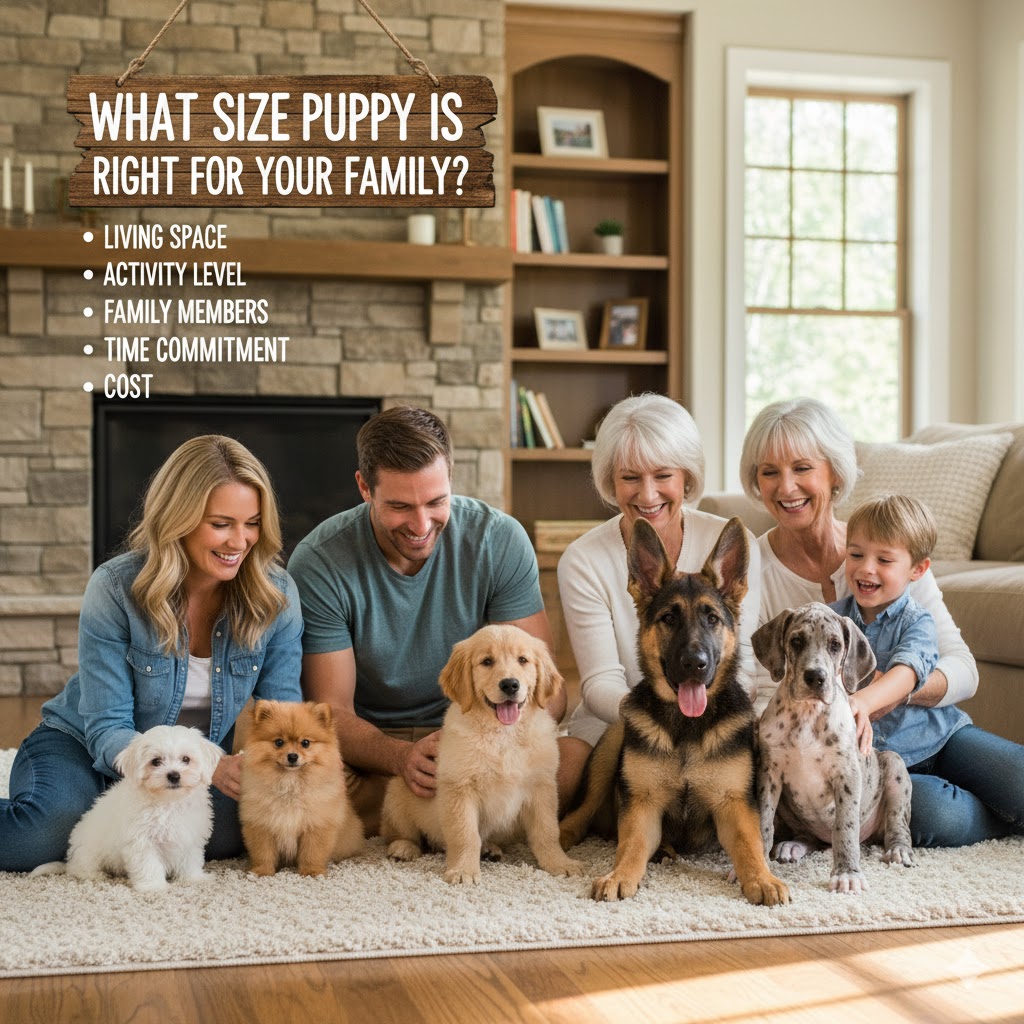
Bringing home a puppy is an exciting decision — one filled with love, laughter, and new adventures. But before you fall in love with those puppy eyes, it’s important to ask one big question: What size puppy is right for your family?
Choosing between a small, medium, or large breed goes beyond looks. The right puppy size should match your lifestyle, space, energy level, and family dynamic. In this guide, we’ll help you understand how to pick the best fit — so your new furry friend feels perfectly at home with you. For more expert breed insights and puppy care tips, visit PetsDogPuppy, a trusted source for everything related to raising happy, healthy dogs.
Understanding Puppy Sizes
Before diving in, let’s quickly define the three main categories of dog sizes:
- Small Breeds: Typically under 20 pounds (like Chihuahuas, Shih Tzus, and Toy Poodles)
- Medium Breeds: Between 20–60 pounds (like Beagles, Border Collies, and Cocker Spaniels)
- Large Breeds: Over 60 pounds (like Labradors, Golden Retrievers, and German Shepherds)
Each size comes with unique needs, challenges, and rewards — so let’s explore which might be the best match for your family’s lifestyle.
Small Breeds: Perfect for Apartments and Busy Lifestyles
Small dogs are adorable, portable, and often ideal for first-time dog owners or those with limited living space.
Pros of Small Breeds:
- Ideal for small homes or apartments: They don’t need as much room to roam.
- Easier to handle: Carrying them, bathing them, or traveling with them is simple.
- Lower food costs: Smaller dogs eat less, which means lower expenses.
- Longer lifespans: Many toy breeds live 12–16 years or more.
Cons of Small Breeds:
- Fragile around small children: Tiny pups can get injured during rough play.
- High-pitched barking: Breeds like Chihuahuas or Yorkies can be vocal.
- “Small dog syndrome”: Without consistent training, small dogs may develop bossy or anxious behavior.
Real-Life Example:
The Johnson family, who live in a two-bedroom apartment in Austin, chose a Pomeranian because they wanted a cuddly but low-exercise companion. With regular short walks and indoor playtime, their Pomeranian fits perfectly into their busy city lifestyle.
If you live in an apartment or have limited outdoor space, a small breed may be your best match. For more small dog care tips and training advice, check out the breed guides available on PetsDogPuppy.
Medium Breeds: The Balanced Family Choice
Medium-sized dogs are often described as the “best of both worlds.” They’re large enough to play and exercise with, yet small enough to manage easily indoors.
Pros of Medium Breeds:
- Adaptable: They adjust well to both apartments and houses with yards.
- Great with children: Many medium breeds are gentle and tolerant.
- Moderate exercise needs: They require daily activity but not overwhelming amounts.
- Versatile: Medium dogs can be lap companions or active partners.
Cons of Medium Breeds:
- May need more training: Active breeds like Border Collies need consistent engagement.
- Moderate shedding and grooming: Maintenance levels can vary widely.
- Slightly shorter lifespan: Typically 10–14 years, depending on the breed.
Real-Life Example:
The Patel family in Dallas wanted a dog that could play with their kids but also relax indoors. They chose a Beagle, a friendly and curious medium breed. The Beagle loves family walks, backyard games, and cuddles — making it a perfect all-around companion.
If you want a dog that can balance family life, exercise, and affection, medium breeds are often a great fit. You can explore a variety of family-friendly breed options on PetsDogPuppy to find your match.
Large Breeds: Loyal Companions for Active Families
Large dogs are affectionate, protective, and often make wonderful family guardians. They tend to bond deeply with their owners and thrive when given enough space and exercise.
Pros of Large Breeds:
- Great for families with yards: They love open spaces to play and run.
- Loyal and protective: Many large breeds are naturally watchful and gentle with children.
- Excellent outdoor companions: Ideal for hiking, running, or active lifestyles.
- Calmer indoors: Once exercised, large breeds often enjoy lounging quietly at home.
Cons of Large Breeds:
- Require more space: They’re not ideal for small apartments.
- Higher food and medical costs: Bigger dogs mean bigger expenses.
- Shorter lifespans: Most large breeds live 8–12 years.
- Training is essential: Without structure, a strong dog can become hard to manage.
Real-Life Example:
The Wilson family, who live in a suburban home with a big backyard, brought home a Labrador Retriever. Their Lab quickly became part of the family — joining morning jogs, playing fetch with the kids, and napping by the sofa. The large size was a perfect match for their active, outdoor-loving lifestyle.
For large dog care guides, feeding recommendations, and training resources, visit PetsDogPuppy.
Matching Puppy Size to Your Lifestyle
Here’s a quick checklist to help narrow down the best puppy size for your family:
1. Home Space:
- Small apartment or condo → Small breed
- Medium house with yard → Medium breed
- Spacious home with large yard → Large breed
2. Activity Level:
- Low activity (short walks) → Small breed
- Moderate (daily play and walks) → Medium breed
- High (hiking, running, outdoor play) → Large breed
3. Children and Family Members:
- Young children → Medium breeds are typically sturdier and gentler.
- Older kids and teens → Any size can work with proper training.
4. Time Commitment:
- Limited time for grooming/training → Choose a small or low-maintenance medium breed.
- Lots of time for training, exercise, and bonding → Large breeds are ideal companions.
Pros and Cons Summary
| Size | Pros | Cons |
|---|---|---|
| Small Breeds | Great for small homes, easy travel, lower cost | Fragile, can bark more, need gentle handling |
| Medium Breeds | Adaptable, family-friendly, balanced energy | Moderate shedding, need daily walks |
| Large Breeds | Loyal, protective, great exercise partners | Need space, cost more, shorter lifespan |
Finding the Perfect Fit
Ultimately, the best puppy size depends on your lifestyle. A small puppy brings convenience, a medium dog brings balance, and a large breed offers companionship and adventure. Every size has its charm — the goal is to find the one that fits your family’s heart and home.
If you’re still unsure, explore breed profiles, puppy size guides, and expert tips at PetsDogPuppy. The site offers valuable insights into behavior, care, and breed selection to help you make the right choice for your household.
Final Thoughts
Choosing the right puppy size is the first step toward years of love and joy with your new furry friend. Whether you’re drawn to a tiny lap dog, an energetic medium pup, or a gentle giant, the key is understanding your family’s needs and finding the perfect match.
